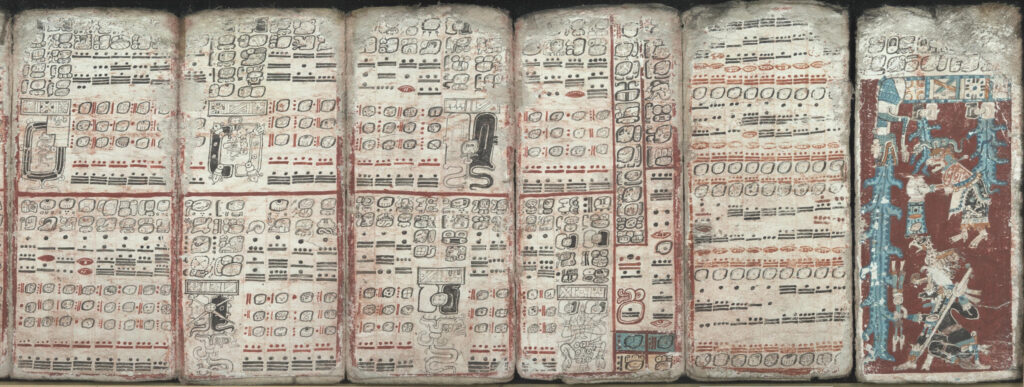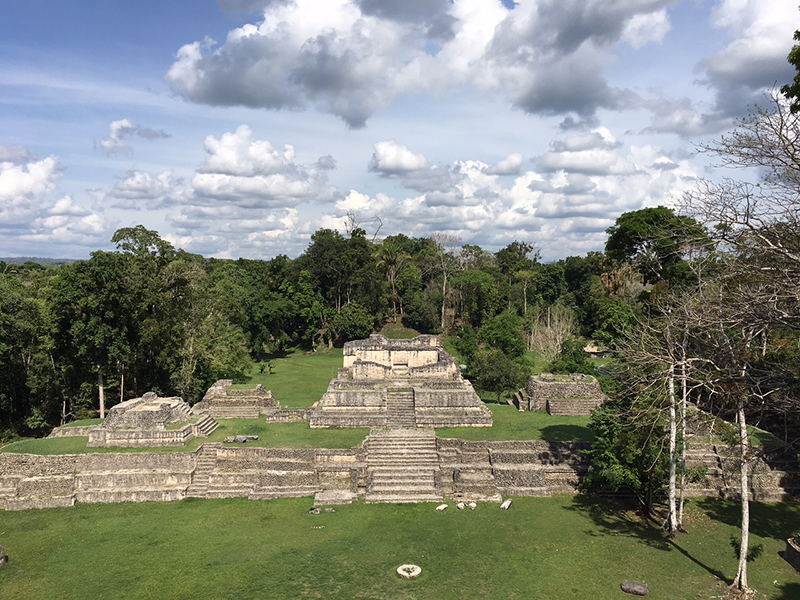I found this article and it was very interesting
so I thought I would share it.
...skywizard
Modern astronomical techniques have uncovered clues
to a possible facet of Mayan astronomy from nearly 2
millennia ago not found in surviving records.
The ruins of the Temple of the Jaguar (Temple I) and the North Acropolis loom over what remains
of the ancient Mayan city of Tikal in El Petén, Guatemala. Two major events in the city, the
coronation of the 6-year-old Lady of Tikal in 511 CE and a defeat by the city-state Caracol in the
562 CE “Star War,” took place in approximate synchrony with meteor outbursts. Recently published
research suggests that the Maya may have linked the timings of events such as royal accessions
and wars to astronomical predictions of meteor showers. Credit: Jon G. Fuller
Using state-of-the-art computer models, an amateur historian and a professional astronomer have found evidence that many important societal events recorded in Mayan hieroglyphic inscriptions may coincide with outbursts of meteor showers related to Halley’s Comet.
In newly published research, the two-person research team has found more than a dozen instances of hieroglyphic records from the Mayan Classic Period (250–909 CE) indicating that important events occurred within just a few days of an outburst of Eta Aquariid meteor showers, one of the celestial displays tied to the comet.
No Mayan astronomical records from that period survived the Spanish invasion, and the four surviving Mayan codices from later eras do not mention meteor showers. However, the researchers suspect that many significant historical events that coincided with meteor showers, like a ruler’s assumption of power or a declaration of war recorded in the codices and carved in stone monuments, are not chance overlaps.
Instead, the Maya most likely predicted meteor showers, the researchers argue in a paper, already available online, that will be published in the 15 September issue of Planetary and Space Science. What’s more, the ancient civilization might have purposefully timed significant occasions to coincide with portentous celestial events.
If this new research is validated by further computational tests, it would help address a longstanding puzzle, said David Asher, an astronomy research fellow at Armagh Observatory in Northern Ireland: How did the ancient Maya, a civilization that meticulously recorded astronomical information about Venus, eclipses, and seasonal patterns, fail to note meteor showers in their astronomical studies? They likely did record meteor showers, assert Asher and his colleague Hutch Kinsman, who has been an independent scholar of Mayan history and hieroglyphics for nearly 25 years, but the records were lost to us.
Modern Science Answers Puzzles from Ancient Times
Experts in Mayan hieroglyphic astronomy widely acknowledge that the Maya observed and recorded three types of common astronomical events during the Classic Period: phases of the Moon, solar and lunar eclipses, and the movement of Venus. Kinsman and other historians have wondered whether the Maya overlooked meteor showers or if they noted them.
The oldest surviving Maya codex, the Dresden Codex, dating to circa 1200 CE, contains astronomical almanacs. These sheets
from the Dresden Codex depict eclipses (sheets 55–57; left three), multiplication tables (sheets 58–59; second and third from
the right), and a flood (sheet 74; right). Click the image to see a larger version. Credit: Saxon State Library
Although mentions of the meteor showers themselves are missing from Mayan codices, Kinsman and Asher used computer models that track the motions and interactions of orbiting objects to calculate dates when the Eta Aquariid meteor shower, born from remnants of Halley’s Comet, would have been visible to the Maya during the Classic Period. They checked their calculated meteor shower dates against Chinese astronomical records from the same time period.
Halley’s Comet leaves behind a trail of would-be meteors when it passes by Earth about every 75 years. The comet debris can remain in orbit for hundreds or thousands of years before entering Earth’s atmosphere or may never intercept Earth at all. Asher, an expert in solar system dynamics, explained that when modern astronomers try to predict the positions of small chunks of rock and ice hundreds of years after they broke off from a parent comet, they “need a comet whose orbit was well known before the time when you hypothesize that the Maya might have observed the meteor outburst. Halley’s Comet fits the bill quite nicely,” he added.
The comet’s remnants produce a few very predictable and large meteor showers, including the Eta Aquariid shower, which is typically observable from April to May across northern to southern midlatitudes. “The Eta Aquariids were the natural choice for research,” Kinsman said.
Meteor Outbursts Coincide with Ascents to Power
After the researchers predicted dates during the Classic Period when Eta Aquariid outbursts likely occurred, they then searched for significant events recorded in Mayan hieroglyphics that took place on or near those dates, attempting to see if the Maya, like other ancient civilizations, used meteor showers as portents of greatness.
“The approach we’ve taken is to look for coinciding dates,” Asher explained. “There are dates on the Maya[n] inscriptions, and Mayanist experts can tell us what they are.…Orbital computations give dates when meteor outbursts occur[ed].”
The researchers’ models suggested 18 different Eta Aquariid meteor outbursts that were likely visible to the ancient Maya during the Classic Period. A third of those meteor showers occurred within 4 days of a ruler ascending the throne, and other showers correlated with declarations of war, important people traveling between cities, or agricultural or industrial activities. “With coinciding dates, we start to have evidence rather than (interesting) speculation,” Asher said.
The strongest meteor outburst that Kinsman and Asher pinned down to a particular date occurred on 10 April 531 CE, when three different comet trails intercepted Earth at the same time. They indicate in their paper that this extreme outburst was “likely the most intense that the Maya would have seen during the Classic Period.” Four days after the 531 CE Eta Aquariid outburst, the ruler K’an I ascended to power in Caracol (in modern Belize).
Archaeoastronomy: Two Research Fields, One Idea
Kinsman began investigating whether the Maya had observed comets or meteors back in 2011. He met Asher at the Meteoroids 2013 conference in Poznań, Poland, where Kinsman was presenting preliminary work on the Maya and meteors.
“It captures the imagination,” Asher said. “I was so fascinated to hear Hutch’s lecture four years ago…I thought, ‘Oh, that sounds interesting!’”
Ruins of the Maya temple designated “Structure A6” at the center of the Mayan ruins in Caracol,
Belize, photographed on 7 May. The ancient city was the site of a royal accession in 531 CE, 4 days
after an extremely bright outburst of the Eta Aquariid meteor shower. Credit: Hutch Kinsman
The two began collaborating in early 2015 and completed most of their work when Kinsman was invited to visit Armagh Observatory that summer. This research was a departure from the norm for both Kinsman and Asher, their first steps into the collaborative field of archaeoastronomy.
The fruit of this first venture is producing mixed reactions from other experts in Mayan history and hieroglyphics.
Their work “is a valid beginning toward the study of an important and likely historical insight into the timing of Maya[n] ceremonial events,” Mark Van Stone, a professor and art historian at Southwestern College in Chula Vista, Calif., told Eos.
However, John Henderson, a professor of anthropology at Cornell University in Ithaca, N.Y., cautioned that the researchers’ results merely imply a statistical correlation between meteor outbursts and meaningful events; the team made no attempt to identify a Maya logic for the connections or reanalyze Maya codices, he noted.
Perhaps if the correlations all applied to a single kind of event or if the celestial events occurred more closely in time to the terrestrial ones, he would find the results more persuasive, Henderson added.
Expanding to Other Meteor Showers
No other researchers have conducted a comprehensive search before for possible meteor events across the entire Mayan Classic Period, said Kinsman. Previous attempts to connect meteor activity and historical events in pre-Hispanic Western civilizations have focused on only one or two meteor events at a time.
He and Asher plan to continue their Mayan archaeoastronomy investigation by analyzing other prominent meteor showers like the Orionids and Perseids, he said. Kinsman is already running their computer model to predict Orionid outbursts during the Mayan Classic Period.
“That’s what makes [this idea] exciting,” Asher explained, “when it draws together two topics which are on the face of it very different but realizing that there’s actually a connection there.”
—Kimberly M. S. Cartier
Source: https://eos.org/articles/ancient-may...meteor-showers
...peace







 Reply With Quote
Reply With Quote
Bookmarks